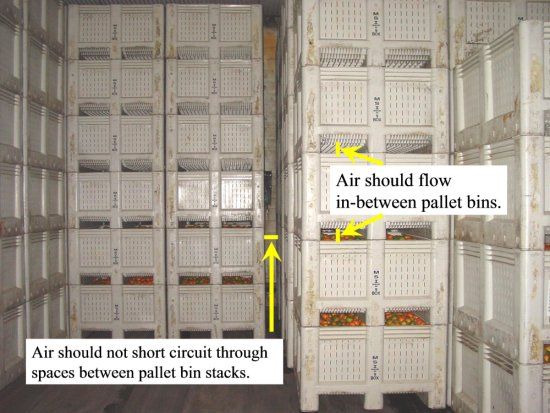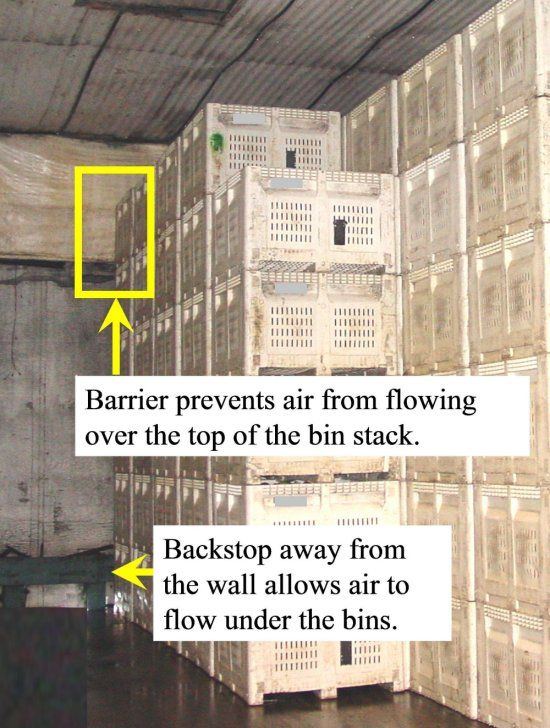Early varieties of citrus fruit in Florida usually meet legal maturity standards before the peel attains the characteristic varietal color and therefore require degreening. Occasionally, later maturing varieties may similarly require degreening. The degreening process, which involves the use of ethylene gas in specially constructed degreening rooms, destroys the chlorophyll and allows the yellow or orange peel to predominate.
Recommended Degreening Conditions
Temperature
Temperatures of 82°F to 85°F (28°C to 29°C) are recommended for degreening. Both higher and lower temperatures tend to slow the degreening process. Florida Department of Citrus Rules, Chapter 20–31 prohibits degreening with temperatures exceeding 85°F by application of heat, except when the added heat comes from steam used to increase humidity. The thermostat controlling the heat exchanger should be located in the air stream between the fan-radiator unit and the fruit. Gas heaters are usually placed outside of the room to reduce high humidity corrosion.
Ethylene
Five parts per million (ppm) ethylene is adequate for the maximum degreening rate when using recommended conditions. Some packers are successfully using three ppm ethylene. Ethylene should be accurately metered into degreening rooms. Metering may be accomplished with a needle valve using the trickle system for smaller rooms at the initial rate of one bubble per minute for each 10-field box capacity of the room. Large rooms require a flow meter which can be initially set using Table 1 as a guide. Each flow meter will be calibrated in terms of one of the last three columns in Table 1. If flow rates greater than those listed in Table 1 are needed to maintain ethylene at desired levels, excessive ventilation is the probable cause.
After conditions in the degreening room have stabilized, the concentrations of ethylene can be easily measured with a portable ethylene analyzer which every packinghouse should have (Figure 1). Adjust the amount of ethylene entering the room to maintain 3–5 ppm. When several large rooms are on the same ethylene line, each flow meter should be equipped with a pressure regulating diaphragm so that turning one room off or on does not affect the flow to the other rooms.

Humidity
Relative humidity (RH) of 90%–95% is recommended for degreening and can be maintained by steam or pneumatic atomizing nozzles which mix water with air. When room temperatures are already over 85°F, the addition of undesirable heat is avoided when using pneumatic atomizing nozzles. Wet and dry bulb thermometer units placed in a position of strong air movement can be used to determine relative humidity. The difference in temperature between wet and dry bulb readings should be 1°F to 2°F. When humidity is automatically controlled, the sensing unit (humidistat) should be in the air stream returning to the fan, but moisture is best added to the air stream between the heat exchanger and the fruit.
Ventilation
Fresh air should enter the room at the rate of one air change per hour, based on the volume of the empty room. A sliding door or damper can be used to adjust the amount of air entering the room on the intake (low pressure) side of the fan. Once the setting is made, no further adjustment is necessary. Fresh air will prevent accumulation of carbon dioxide (CO2), which is given off by the fruit. The rate of degreening is reduced if the CO2 concentration reaches 0.1% and will nearly stop it at 1.0% or above. A constant supply of fresh air eliminates any need to periodically open rooms for ventilation. On the other hand, many degreening rooms have a much higher rate of air exchange than is required, which can be expensive because of the loss of heat, humidity and ethylene.
Air Circulation
Air movement should be a minimum of 10 cubic feet per minute (CFM) per field box or 100 CFM per pallet box. This air flow rate is necessary to maintain uniform temperature, ethylene concentration, and humidity at the surface of each fruit in the degreening room.
Operational Considerations
Design and load degreening rooms so that wall ducts in the back of the room direct air to channels formed by the pallets and avoid wasted short-circuited air between pallet bin stacks (Figure 2). Likewise, air should be blocked from flowing over the top of the bin stack (Figures 3 and 4). Avoid air restrictions, which create turbulence and waste energy. Typically, the air duct velocity should be less than 1500 linear feet per minute to mitigate excessive horsepower requirements from friction losses. One truck load should constitute one or two rows of bins for optimal forklift handling. First in-first out may not be the case depending upon the specific crop and variety.



Keep heat exchanger units clean and fans properly serviced. Dirt on the coils acts as an insulator and reduces coil efficiency. Pulling air through the heat exchanger uses less energy than pushing air through.
Insulation is the obvious means to conserve heat during cool weather and to reduce heating during hot weather. Outside metal walls and the underside of metal roofs need to be insulated. Cement block walls do not need additional insulation but the inside should be painted with a latex paint to reduce moisture loss.
All equipment should have easy access. The area above the false ceiling and below the roof is most often neglected. A solid catwalk and good lighting is worth the cost to provide access to the fans, radiators, and other equipment in that area. The false ceiling should have a slight pitch so that water does not accumulate overhead.
Maintaining high humidity involves some risk of water condensing on the fruit. With the exception of grapefruit, experience has shown that moisture on citrus fruits will not retard degreening. Degreen under high humidity (but not wet) conditions.
Degreening with ethylene increases decay. Fruit should not be exposed to concentrations greater than the 5 ppm needed for degreening. Also, fruit should not be exposed to ethylene longer than necessary to obtain degreening.
Degreening tests should be made with sample pickings of fruit early in the season to determine if the peel is mature enough to degreen properly. This is especially important with early-maturing, mandarin-type citrus fruits. If mandarins require longer than 36 hours to degreen, decay usually will be excessive.
Safe Handling of Ethylene
Ethylene gas used for degreening is sold in compressed gas cylinders containing slightly less than 100% ethylene and has a mild sweetish smell. Some packers are utilizing ethylene generators. Though non-toxic, ethylene can cause asphyxiation under very high concentrations as the gas displaces oxygen in the atmosphere. Ethylene is explosive at concentrations between 3.1% and 32% (by volume) in air. These are extremely high concentrations (3.1% = 31,000 ppm) compared to normal citrus degreening concentrations of about 5 ppm but may occur through accidental increases in ethylene flow or leaks in ethylene lines or regulators. Occasionally, one reads of an ethylene ripening room exploding that tragically kills and/or injures people. These serve as potent reminders that safety considerations are important when dealing with ethylene. Be sure to follow these important safety rules when working with ethylene:
Do not move compressed gas cylinders without the cover cap in place (it protects the valve). Only remove the cap when the cylinder is in place and ready to be used. There are vivid stories of cylinders, turned into a rocket when the valve stem breaks.
Securely fasten cylinders to walls, holding cages or other non-tip structures.
Check for gas leaks using a solution of soapy water. If the cylinder is leaking, contact your service provider and have it replaced.
Verify that ethylene flow regulators are operating correctly.
Keep flames or spark producing equipment away from degreening rooms and ethylene cylinders. Post and observe no smoking signs in these areas. All piping should be grounded to prevent electrostatic discharge.
Check ethylene flow often to ensure safe concentrations are maintained. Some ethylene monitoring equipment will sound an alarm if concentrations become too high.
Future Recommendations
For new or amended recommendations, follow the Packinghouse Newsletter and other materials posted at the University of Florida Postharvest Programs and information website http://postharvest.ifas.ufl.edu.